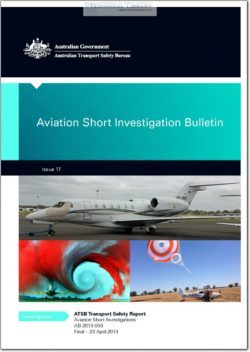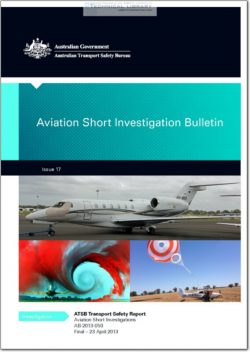ATSB-AB-2013-050

- Version
- 187 Downloads
- 3.41 MB File Size
- 1 File Count
- August 8, 2016 Create Date
- August 8, 2016 Last Updated
Aviation Short Investigation Bulletin - Issue 17

On 13 September 2012, at about 1619 Coordinated Universal
Time (UTC)1, a Virgin Australia Boeing 737 aircraft (B737),
registered VH-YIO (YIO), departed Bali International Airport
(Denpasar), Indonesia on a scheduled passenger service to
Brisbane, Queensland. On board the aircraft were six crew
and 132 passengers. The first officer (F0) was designated as
the pilot flying.
During the climb, the crew requested a cruise altitude of flight
level (FL)2 370 from Indonesian air traffic control (ATC), Source: NASA
however, due to traffic at FL360, the crew were assigned
FL350. The crew reported calm wind conditions at the time.
At 1639, the aircraft became established in the cruise and the seat belt sign was turned off.
Shortly after, the crew observed opposite direction traffic on the aircraft’s traffic alert and collision
avoidance system (TCAS), about 1,000 ft above and slightly to the left. The crew observed the
aircraft pass to the left. Airservices Australia surveillance data indicated the aircraft passed at
about 1640, with about 0.9 NM lateral and 1,400 ft vertical separation (Figure 1).
At 1641, the FO reported that they felt ‘cobblestone’ like turbulence. The aircraft then experienced
a wake-induced roll, initially to the right and then suddenly to the left, which the crew estimated to
be to an angle of 45°. The crew received an enhanced ground proximity warning system
(EGPWS) bank angle warning and the autopilot control wheel steering mode3 engaged. As the roll
to the left commenced, the crew immediately responded by applying full right aileron deflection.
The crew reported that the aircraft initially continued to roll left, but the roll then arrested and
straight-and-level flight was resumed.
Radar surveillance data indicated that, at the time of the event, there was about 2.1 NM lateral
and 1,400 ft vertical separation (Figure 2) between the aircraft and the correct ATC separation
standards were being applied at the time.
The captain spoke to the cabin supervisor (CS) who advised of nil injuries. He then contacted ATC
requesting information on the passing aircraft. Air traffic control advised that the aircraft was an
Airbus A380 (A380) aircraft operated by Emirates. The captain then made a passenger
announcement over the public address system (PA) and also went out into the cabin. He spoke to
the CS again who advised that all the passengers were seated at the time of the incident. The
flight continued without further incident.
| File | Action |
|---|---|
| ATSB-AB-2013-050 Aviation Short Investigation Bulletin - Issue 17.pdf | Download |

Comment On This Post